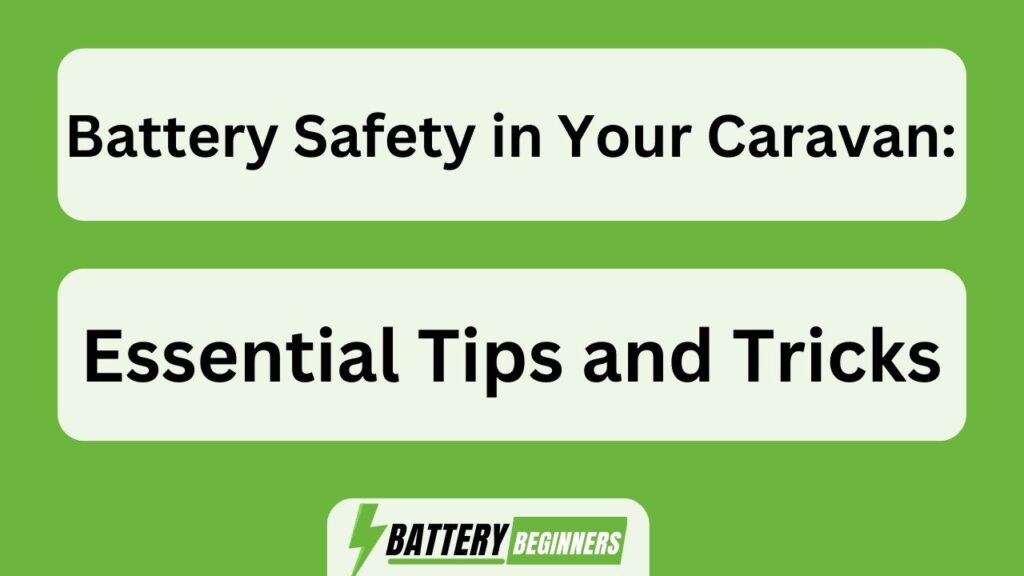Battery safety is of utmost importance when it comes to your caravan. As avid travelers and enthusiasts ourselves, we understand the significance of ensuring that your battery remains reliable and safe throughout your adventures. That’s why we have compiled a comprehensive guide on battery safety, filled with essential tips and tricks to keep you well-prepared on the road.
In this article, we will delve into various aspects of battery safety, covering everything from understanding different types and capacities of batteries to proper installation and maintenance techniques. We will also explore best practices for charging batteries, handling and transporting them safely, as well as monitoring their health and performance.
Additionally, we will discuss emergency procedures that every caravan owner should be aware of in case unforeseen situations arise. Furthermore, investing in battery accessories and safety devices can provide an extra layer of protection for both you and your battery.
Join us as we embark on this journey to ensure a safe and worry-free experience with your caravan’s battery. Stay informed, seek professional advice when needed, and let’s make battery safety our top priority!
Key Takeaways
- Importance of battery safety in caravans
- Understanding the different types and capacities of batteries
- Emphasizing proper battery installation, maintenance, and charging practices
- Implementing emergency procedures and precautions for battery safety
Understand Battery Types and Capacities
When it comes to battery safety in your caravan, understanding the different types and capacities is essential for smooth and worry-free traveling. Proper battery maintenance and charging procedures are crucial for ensuring the longevity and reliability of your caravan’s electrical system.
There are various types of batteries commonly used in caravans, including lead-acid, lithium-ion, and gel batteries. Each type has its own advantages and disadvantages in terms of cost, weight, lifespan, and performance. It is important to choose a battery that suits your specific needs and requirements.
Battery capacity refers to the amount of energy a battery can store. It is measured in ampere-hours (Ah) or milliampere-hours (mAh). Understanding the capacity of your caravan’s batteries is vital as it determines how long they can power your appliances without needing recharging. Additionally, knowing the correct battery charging procedures will help prolong their lifespan and prevent damage.
Proper battery installation and maintenance go hand-in-hand with understanding battery types and capacities. By following manufacturer guidelines for installation, regularly inspecting connections for corrosion or loose wires, cleaning terminals with a wire brush, using appropriate charging equipment, and storing batteries correctly during periods of non-use or winter storage, you can ensure optimal performance from your caravan’s batteries.
By familiarizing yourself with different battery types and capacities while adhering to proper installation techniques along with regular maintenance routines such as cleaning terminals and using correct charging procedures, you will help safeguard your caravan’s electrical system for worry-free adventures on the road ahead.
Proper Battery Installation and Maintenance
To ensure a trouble-free trip, make sure you’ve installed and maintained your battery correctly. Proper battery installation and maintenance are essential for the safety and longevity of your caravan’s electrical system.
When installing a new battery, always refer to the manufacturer’s instructions to avoid common mistakes such as incorrect wiring or insufficient ventilation. Regularly check the battery terminals for corrosion and clean them if necessary. It is also important to keep an eye on the electrolyte levels in flooded lead-acid batteries and top them up with distilled water as needed. Additionally, regularly inspect the battery case for any signs of damage or leaks.
By following these battery maintenance tips and avoiding common installation mistakes, you can ensure that your caravan’s electrical system operates optimally during your travels.
Now let’s move on to implementing battery charging best practices…
Implement Battery Charging Best Practices
Ensure a trouble-free trip by following the best practices for charging your batteries. Proper battery charging techniques are essential for maximizing battery lifespan and ensuring that you have enough power during your caravan adventures.
Start by using a dedicated charger specifically designed for deep cycle batteries, as this will provide a controlled and efficient charge. Avoid overcharging or undercharging the batteries, as both can lead to reduced performance and shortened lifespan.
It’s also important to regularly check and clean the battery terminals to prevent corrosion and maintain good electrical connections. By following these guidelines, you can ensure that your batteries remain in optimal condition throughout your travels.
Safely handle and transport batteries by securely fastening them in place to prevent damage while on the move.
Safely Handle and Transport Batteries
Properly securing your batteries is crucial for preventing any damage while traveling in your caravan. When it comes to battery safety, it’s not just about charging and maintenance; it also involves handling and transporting them safely. To ensure the well-being of both yourself and your batteries, follow these essential guidelines for battery disposal.
First, never dispose of batteries in regular trash bins or burn them, as they contain hazardous chemicals that can harm the environment. Instead, locate a designated recycling center or contact your local waste management facility for proper battery disposal methods. This ensures that the batteries are disposed of correctly and recycled in an environmentally friendly manner. By adhering to these battery disposal guidelines, you contribute to a safer and cleaner environment.
Moving on to the next section about monitoring battery health and performance…
Monitor Battery Health and Performance
One important aspect to keep in mind is monitoring the health and performance of your batteries. A study has shown that regularly checking battery voltage levels can increase their lifespan by up to 30%. Battery testing is crucial to ensure that your caravan’s batteries are operating at optimal levels. By conducting regular tests, you can identify any potential issues or degradation in performance early on, allowing you to take necessary maintenance steps.
It’s also important to perform routine battery maintenance tasks such as cleaning terminals and ensuring proper ventilation. Taking these proactive measures will not only extend the life of your batteries but also enhance their overall performance.
Understanding safety precautions and hazards associated with battery usage should be the next area of focus, as it ensures a secure environment for both yourself and your caravan.
Understand Safety Precautions and Hazards
Understanding the potential risks and dangers associated with battery usage is crucial for creating a safe and secure environment while traveling in your caravan. Proper battery storage is essential to prevent accidents such as leaks, fires, or explosions. It is important to keep batteries in a cool and dry place, away from flammable materials.
Additionally, knowing how to dispose of batteries properly is vital for both your safety and the environment. Batteries contain hazardous materials that can contaminate soil and water if not disposed of correctly. Many places have designated recycling centers where you can drop off old batteries safely.
By following these safety precautions for battery storage and disposal, you can minimize the risk of accidents and ensure a smooth journey in your caravan.
To continue ensuring your safety on the road, it’s also crucial to educate yourself on emergency procedures in case of any battery-related incidents or other emergencies that may arise during your travels.
Educate Yourself on Emergency Procedures
When it comes to emergency procedures in our caravan, we make sure to prioritize safety above all else. We know how important it is to be prepared for any battery-related accidents or malfunctions that may occur. That’s why we educate ourselves on how to safely disconnect or isolate the batteries in case of emergencies.
Additionally, we always have a plan in place and carry a fire extinguisher and first aid kit with us at all times.
Know how to safely disconnect or isolate batteries in case of emergencies
In case of an emergency, imagine yourself as a skilled surgeon delicately disconnecting the batteries in your caravan to ensure everyone’s safety. When it comes to emergency power situations, it’s crucial to know how to safely disconnect or isolate the batteries.
Begin by turning off all appliances and equipment that are connected to the battery system. Next, locate the main battery switch or circuit breaker and turn it off. This will stop the flow of electricity throughout the caravan. It’s important to handle the batteries with extreme caution, wearing appropriate protective gear such as gloves and goggles. Always follow manufacturer instructions when disconnecting or isolating batteries. Remember to stay calm and focused during this process.
Now that you know how to safely disconnect or isolate batteries in emergencies, it’s equally important to have a plan for dealing with battery-related accidents or malfunctions without delay.
Have a plan for dealing with battery-related accidents or malfunctions
It’s crucial to have a solid plan in place for handling any accidents or malfunctions related to your batteries. Battery-related accidents can be dangerous and require immediate action. Here are four important emergency procedures to follow:
- Stay calm: In the event of an accident or malfunction, it’s important to stay calm and think clearly. Panicking can lead to further complications.
- Disconnect power: If there’s a battery-related issue, disconnect the power source immediately. This’ll help prevent any potential fires or further damage.
- Ventilate the area: If there’s a leak or release of gases, ensure proper ventilation by opening windows and doors. This’ll help dissipate any harmful fumes.
- Call for help if necessary: If you can’t resolve the situation on your own, don’t hesitate to call for professional assistance or emergency services.
Remember, safety should always be a top priority when dealing with battery-related incidents. In addition to having a plan in place, it’s also important to carry a fire extinguisher and first aid kit in your caravan for added protection.
Carry a fire extinguisher and first aid kit in your caravan
Make sure you’ve got a fire extinguisher and first aid kit on board, because you never know when emergencies may strike. When it comes to fire extinguisher maintenance, it’s crucial to check the pressure gauge regularly and ensure it is within the recommended range. Also, inspect the canister for any signs of damage or corrosion. As for your first aid kit, make sure it is well-stocked with essentials such as bandages, antiseptic wipes, adhesive tape, pain relievers, and any necessary medications. Remember to replenish any used or expired items promptly. To visually emphasize the importance of these safety measures, here’s a table summarizing potential hazards and their corresponding actions:
| Hazard | Action |
|---|---|
| Fire | Use fire extinguisher |
| Cuts/Bruises | Apply first aid |
| Burns | Cool affected area |
| Loss of Consciousness | Perform CPR if trained |
By being prepared with a fire extinguisher and first aid kit, you can effectively handle battery-related accidents or malfunctions in your caravan. Moving forward into our next topic about battery accessories and safety devices…
Invest in Battery Accessories and Safety Devices
When it comes to battery safety in our caravan, one key point is to use battery boxes or cases to protect our batteries from damage. This not only prevents accidents but also ensures the longevity of our batteries.
Additionally, it’s important to install battery isolators or circuit breakers for added safety, as they help prevent electrical overload and potential fires.
Lastly, considering installing a battery monitoring system provides real-time data on the state of our batteries, allowing us to detect any issues early on and take appropriate action.
Use battery boxes or cases to protect batteries from damage
To ensure the safety of your caravan’s batteries, safeguard them from potential damage by using sturdy battery boxes or cases. These protective enclosures are essential for proper battery storage and handling, as they shield the batteries from external elements that can cause harm. Battery boxes or cases provide a secure and insulated environment, preventing accidental short-circuits, exposure to moisture, and physical damage during transportation.
To give you a better understanding of their importance, here is a table summarizing the benefits of using battery boxes or cases:
| Benefits | Description |
|---|---|
| Protection | Shields batteries against external elements such as water, dust, dirt, and impact. |
| Insulation | Provides thermal insulation to regulate temperature fluctuations and prevent overheating. |
| Organization | Keeps all batteries in one place, minimizing the risk of misplacement or loss. |
| Easy Handling | Simplifies battery transportation with handles and secure fastenings for stability. |
By utilizing these battery accessories for protection and organization purposes, you can now take an additional step towards ensuring the safety of your caravan’s electrical system. Install battery isolators or circuit breakers for added safety…
Install battery isolators or circuit breakers for added safety
For even greater peace of mind, you’ll want to consider installing battery isolators or circuit breakers in your caravan. These devices serve as an additional layer of protection for your batteries, ensuring their safety and preventing potential hazards.
Battery isolators are designed to separate multiple batteries, allowing each to charge and discharge independently. They ensure that a faulty or drained battery won’t affect the others, prolonging their lifespan.
On the other hand, circuit breakers act as automatic switches that interrupt the flow of electricity when a fault is detected, preventing damage from overloading or short circuits. Both options offer significant benefits in terms of safety and reliability.
Consider installing a battery monitoring system for real-time data on your caravan’s power usage and battery health.
Consider installing a battery monitoring system for real-time data
When it comes to battery safety in your caravan, installing battery isolators or circuit breakers is a crucial step. These devices help protect your batteries from overcharging and prevent any electrical mishaps that could potentially damage your caravan or even cause a fire.
However, taking your battery safety to the next level involves considering the installation of a battery monitoring system. A battery monitoring system provides real-time data about the status of your batteries, allowing you to keep track of their voltage levels, current draw, and overall health. This information is essential for ensuring that your batteries are functioning optimally and for detecting any potential issues before they become major problems.
Choosing the right battery monitoring system depends on factors like the size and type of batteries you have, as well as any specific features you may require. It’s important to research different options and consult with experts if needed to ensure you select the most suitable system for your caravan setup.
Now let’s move on to the next section where we discuss how regularly inspecting and cleaning battery connections is another vital aspect of maintaining battery safety in your caravan.
Regularly Inspect and Clean Battery Connections
Check your battery connections regularly and make sure they’re clean and tight, just like how you’d tighten the screws on a favorite childhood toy to keep it working smoothly. Proper battery maintenance is crucial for ensuring its longevity and reliable performance in your caravan.
Over time, corrosion can accumulate on the battery terminals, leading to poor electrical conductivity and potential damage. To prevent this, inspect the connections frequently and clean them if necessary. Start by disconnecting the battery cables and using a wire brush or sandpaper to remove any corrosion or dirt. After cleaning, reattach the cables securely, making sure they’re tightened properly.
By doing this simple task regularly, you can prevent potential issues caused by corroded connections and ensure that your caravan’s battery continues to deliver power efficiently.
Now let’s move on to the next section about staying informed and seeking professional advice for optimal battery safety in your caravan.
Stay Informed and Seek Professional Advice
Staying informed and seeking professional advice can help you maximize the performance and lifespan of your caravan’s battery. It is crucial to stay updated on the latest developments in battery technology and safety measures.
By seeking advice from professionals, you can gain valuable insights and recommendations tailored specifically to your caravan’s battery needs. Here are three key areas where seeking advice and staying informed can make a difference:
- Battery maintenance: Professionals can provide guidance on proper charging techniques, ensuring that you avoid overcharging or undercharging your battery.
- Troubleshooting: If you encounter any issues with your caravan’s battery, seeking advice from experts can help identify the problem quickly and accurately.
- Upgrades: As technology advances, new battery options may become available for caravans. Seeking professional advice allows you to explore these upgrades and determine if they are suitable for your specific needs.
Remember, keeping yourself well-informed and consulting with professionals will ensure that you make informed decisions regarding your caravan’s battery, ultimately maximizing its performance and longevity.
Frequently Asked Questions
Can I use a lithium-ion battery in my caravan?
Yes, absolutely! Using a lithium-ion battery in your caravan is like having a rocket strapped to your back. While there are some pros and cons, overall, they offer great power and efficiency for all your adventures on the road.
How often should I check the water levels in my caravan battery?
We recommend checking the water levels in your caravan battery every month. This is an essential maintenance tip to ensure optimal performance and longevity of your battery. Regular checks can prevent damage and extend its lifespan.
What is the recommended charging voltage for my caravan battery?
The recommended charging voltage for our caravan battery is between 13.8 and 14.4 volts. It’s important to stay within this optimal voltage range to ensure efficient and safe charging of the battery.
Are there any specific regulations for transporting caravan batteries on airplanes?
When it comes to transporting caravan batteries on airplanes, there are specific regulations and restrictions in place for safety reasons. It is important to follow these guidelines and take necessary precautions during air travel with caravan batteries.
Is it necessary to have a battery monitor or management system for my caravan battery?
Having a battery monitor or management system for your caravan battery is essential. It allows you to easily keep track of battery levels and ensures proper maintenance, maximizing the lifespan of your battery. Don’t overlook its importance!
Conclusion
In conclusion, when it comes to ensuring battery safety in your caravan, knowledge is power. By understanding the different types and capacities of batteries, as well as properly installing and maintaining them, you can avoid potential hazards.
Implementing best practices for charging, handling, and transporting batteries will further enhance safety. Regular monitoring, education on emergency procedures, and investing in accessories will provide added peace of mind. Remember to regularly inspect and clean connections for optimal performance.
Stay informed and seek professional advice for a worry-free journey. Happy travels!






